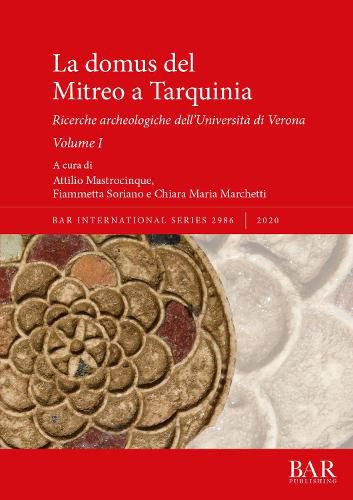Readings Newsletter
Become a Readings Member to make your shopping experience even easier.
Sign in or sign up for free!
You’re not far away from qualifying for FREE standard shipping within Australia
You’ve qualified for FREE standard shipping within Australia
The cart is loading…






This title is printed to order. This book may have been self-published. If so, we cannot guarantee the quality of the content. In the main most books will have gone through the editing process however some may not. We therefore suggest that you be aware of this before ordering this book. If in doubt check either the author or publisher’s details as we are unable to accept any returns unless they are faulty. Please contact us if you have any questions.
La domus del Mitreo a Tarquinia presenta i risultati della ricerca archeologica a Tarquinia dal 2016 al 2018. Lo scavo di un grande complesso ha fornito documentazione della Tarquinia romana tra il III secolo a.C. e la tarda antichita. Chiodi votivi inscritti in latino e una fontana con un serbatoio d'acqua nascosto nelle sue pareti sono caratteristiche originali di questo edificio, da cui e venuta alla luce anche una statua di Mitra. I risultati mostrano due fasi principali: una nel II secolo a.C. e un'altra in eta augustea. Anche le fasi finali sono importanti: nel IV secolo si verifico un crollo e l'area fu rialzata e livellata quasi ovunque e infine abbandonata nel VII secolo.
La domus del Mitreo a Tarquinia presents the results of archaeological research in Tarquinia from 2016 to 2018. The excavation of a large complex provided us with rich documentation of Roman Tarquinia between the 3rd century BCE and Late Antiquity. Votive nails inscribed in Latin and a fountain with a water reservoir concealed in its walls are original features of this building, from which a statue of Mithras also came to light. The results show two main phases: one in the 2nd century BCE and another in the Augustan Age. The final phases are also important: in the 4th century a collapse occurred and the area was raised and flattened almost everywhere and finally abandoned in the 7th century.
$9.00 standard shipping within Australia
FREE standard shipping within Australia for orders over $100.00
Express & International shipping calculated at checkout
This title is printed to order. This book may have been self-published. If so, we cannot guarantee the quality of the content. In the main most books will have gone through the editing process however some may not. We therefore suggest that you be aware of this before ordering this book. If in doubt check either the author or publisher’s details as we are unable to accept any returns unless they are faulty. Please contact us if you have any questions.
La domus del Mitreo a Tarquinia presenta i risultati della ricerca archeologica a Tarquinia dal 2016 al 2018. Lo scavo di un grande complesso ha fornito documentazione della Tarquinia romana tra il III secolo a.C. e la tarda antichita. Chiodi votivi inscritti in latino e una fontana con un serbatoio d'acqua nascosto nelle sue pareti sono caratteristiche originali di questo edificio, da cui e venuta alla luce anche una statua di Mitra. I risultati mostrano due fasi principali: una nel II secolo a.C. e un'altra in eta augustea. Anche le fasi finali sono importanti: nel IV secolo si verifico un crollo e l'area fu rialzata e livellata quasi ovunque e infine abbandonata nel VII secolo.
La domus del Mitreo a Tarquinia presents the results of archaeological research in Tarquinia from 2016 to 2018. The excavation of a large complex provided us with rich documentation of Roman Tarquinia between the 3rd century BCE and Late Antiquity. Votive nails inscribed in Latin and a fountain with a water reservoir concealed in its walls are original features of this building, from which a statue of Mithras also came to light. The results show two main phases: one in the 2nd century BCE and another in the Augustan Age. The final phases are also important: in the 4th century a collapse occurred and the area was raised and flattened almost everywhere and finally abandoned in the 7th century.